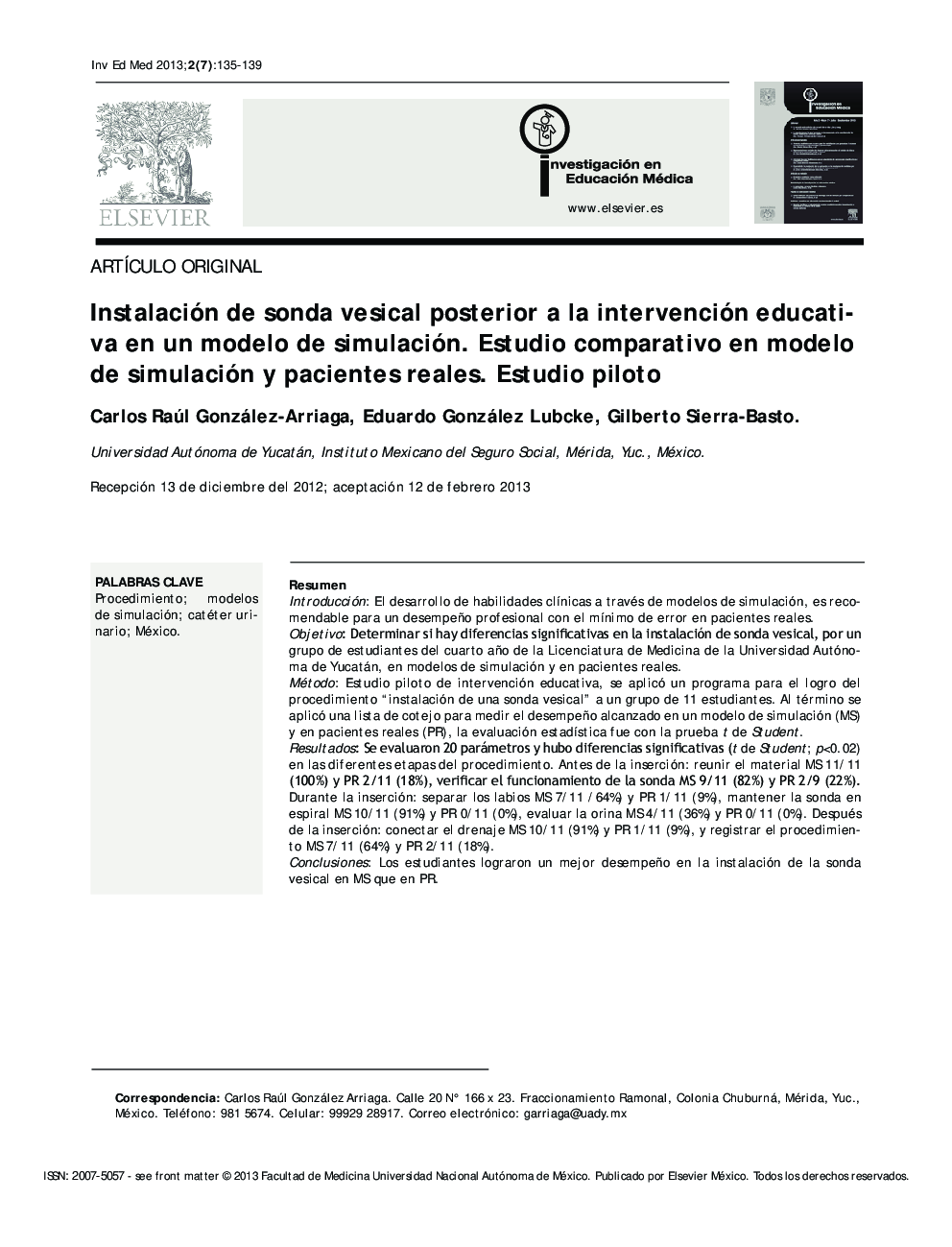| کد مقاله | کد نشریه | سال انتشار | مقاله انگلیسی | نسخه تمام متن |
|---|---|---|---|---|
| 3474668 | 1233155 | 2013 | 5 صفحه PDF | دانلود رایگان |

ResumenIntroducciónEl desarrollo de habilidades clínicas a través de modelos de simulación, es recomendable para un desempeño profesional con el mínimo de error en pacientes reales.ObjetivoDeterminar si hay diferencias significativas en la instalación de sonda vesical, por un grupo de estudiantes del cuarto año de la Licenciatura de Medicina de la Universidad Autónoma de Yucatán, en modelos de simulación y en pacientes reales.MétodoEstudio piloto de intervención educativa, se aplicó un programa para el logro del procedimiento “instalación de una sonda vesical” a un grupo de 11 estudiantes. Al término se aplicó una lista de cotejo para medir el desempeño alcanzado en un modelo de simulación (MS) y en pacientes reales (PR), la evaluación estadística fue con la prueba t de Student.ResultadosSe evaluaron 20 parámetros y hubo diferencias significativas (t de Student; p<0.02) en las diferentes etapas del procedimiento. Antes de la inserción: reunir el material MS 11/11 (100%) y PR 2/11 (18%), verificar el funcionamiento de la sonda MS 9/11 (82%) y PR 2/9 (22%).Durante la inserciónseparar los labios MS 7/11 /64%) y PR 1/11 (9%), mantener la sonda en espiral MS 10/11 (91%) y PR 0/11 (0%), evaluar la orina MS 4/11 (36%) y PR 0/11 (0%). Después de la inserción: conectar el drenaje MS 10/11 (91%) y PR 1/11 (9%), y registrar el procedimiento MS 7/11 (64%) y PR 2/11 (18%).ConclusionesLos estudiantes lograron un mejor desempeño en la instalación de la sonda vesical en MS que en PR.
IntroductionDevelopment of clinical skills through simulation models is essential for a professional performance with minimal error on real patients.ObjectiveDefine if there is a significant difference in the performance of the installation of a urinary catheter between simulation models and real patients from students of the forth year of the medical degree in Universidad Autónoma de Yucatán.MethodWe performed a pilot study of educational intervention, we applied a program to achieve the process “Urinary catheter installation” (one hour theory and fifteen hours of practice per pupil) to a group of 11 students. Afterwards it was apply a checklist to measure the performance achieved in a simulation model (MS) patients and on real patients (PR). Statistical analysis was performed with Student’s t-test.ResultsTwenty parameters were evaluated and found significant differences (p<0.02) in the following steps: Before insertion; gather the material MS 11/11 (100%) and PR 2/11 (18%), verify the operation of urinary catheter MS 9/11 (82%) and PR 2/9 (22%). During insertion; Separate lips MS 7/11/64%) and PR 1/11 (9%), keeping the urinary catheter coiled MS 10/11 (91%) and PR 0/11 (0%), evaluate the characteristics of urine MS 4/11 (36%) and PR 0/11 (0%). After insertion; Connect drainage MS 10/11 (91%) and PR 1/11 (9%) and record the proceedings MS 7/11 (64%) and PR 2/11 (18%).ConclusionsStudents achieve better skills on urinary catheter installation after simulation model training.
Journal: Investigación en Educación Médica - Volume 2, Issue 7, July–September 2013, Pages 135–139